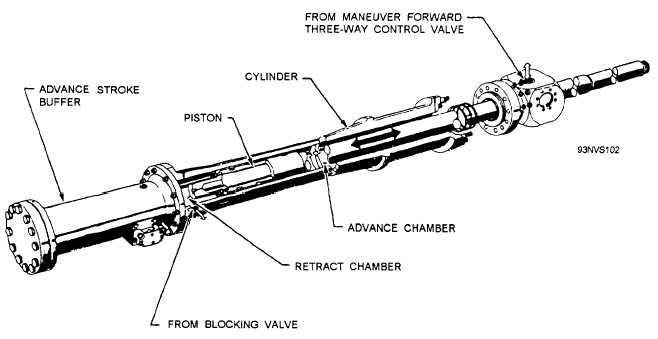Cable Equalizers
RETRACTION SYSTEM
The two cable equalizers, one for the advance
cables and one for the retract cables, maintain equal
tension on each cable. They also minimize whip in the
cable system when the retraction system is operated.
The cable equalizers also provide a means for adjusting
the position of the grab in its battery position, thus
setting the shuttle to its ideal BATTERY position.
Each equalizer consists of a cylinder, a piston rod,
and an adjusting shaft. The cylinder is bolted to the
equalizer support structure of the retraction engine (fig.
4-39).
The advance and retract cable equalizers operate
hydraulically to keep the retraction engine cables tight.
Hydraulic fluid under pressure flows directly into the
cable equalizer, keeping tension on both sets of cables.
When one set of cables is loaded, the other set becomes
slack. Slack is taken out of the retraction-engine cables
by motion of the equalizers. An orifice check valve in
the hydraulic line back to the cable-equalizer reservoir
slows the flow of the fluid and prevents fast motion of
the piston when load is applied. This also permits rapid
flow when removing slack. When one cable equalizer
is working, the adjusting nut on the opposite equalizer
is bottomed and acts as a cable anchor.
The retraction engine, in figure 4-35, provides the
power to retract the shuttle after the catapult has been
fired. It is also used to maneuver the grab forward and
aft. The retraction engine is a double-acting hydraulic
cylinder unit, transferring its motion by means of a
crosshead to the cable drive system. To advance the
grab, pressurized fluid enters the advance chamber of
the retraction-engine cylinder. This forces the piston
and attached crosshead to move. The forward motion is
stopped by the advance buffer. To retract the grab,
pressurized fluid enters the retract chamber of the
cylinder. This reverses the action of the piston and the
crosshead. The retract motion is stopped by the retract
buffer.
Retraction Engine Cylinder and Piston
The retraction engine cylinder and piston (fig. 4-40)
are the main components of the retraction engine. When
pressurized hydraulic fluid enters the advance chamber
of the retraction engine cylinder, the piston moves into
the cylinder. The motion of the piston is carried to the
crosshead and the drive system cables, causing the grab
to move forward. When pressurized hydraulic fluid
enters the retract chamber, the piston is forced out of
the cylinder. The motion of the crosshead and the drive
system cables is reversed, causing the grab to move aft.
Figure 4-40.—Linear retraction engine cylinder and piston.
4-31

